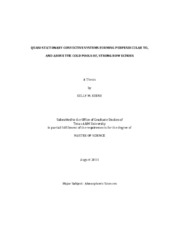| dc.description.abstract | The accurate prediction of warm-season convective systems, and the heavy rainfall and severe weather associated with them, remains a challenge for numerical weather prediction models. This study looks at one such circumstance in which back-building convection forms perpendicular to, and above the cold pool region behind strong bow echoes. We refer to this phenomenon as a "bow and arrow" because, on radar imagery, the two convective lines resemble an archer's bow and arrow. The "arrow" can extend over hundreds of kilometers and can cause damage from high winds, hail and flooding. Events of this nature pose a particular challenge to forecast because they require an accurate forecast of the earlier convection and the effects of that convection on the environment. In this study, radar and surface observations of four events are presented to identify common environmental conditions prior to the development of the back-building convection. Additionally, simulations of three cases using the Weather Research and Forecasting (WRF) model are analyzed in an attempt to understand the mechanisms responsible for initiating and maintaining the convective line. Due to coarse resolution, observational analyses are only useful for inspection of the synoptic-scale. Model output from numerical simulations is utilized to examine the mesoscale in the vicinity of the convective arrow. Several environmental characteristics are evident in each of the studied cases. Strong southwesterly flow (inducing warm air advection and gradual isentropic lifting), in addition to directional and speed convergence into the convective arrow region possibly contribute to convection initiation. Horizontal wind speed shear and increased wind speed in the area surrounding the arrow may be associated with the linear orientation of the arrow. It seems as though when these ingredients are combined with thermodynamic instability, there is a greater possibility of formation and maintenance of a convective arrow behind a bow echo. | en |


